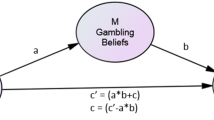Abstract
A number of recent studies have shown there may be a strong cognitive bias in explaining persistent gambling. Theories that have been put forward include the illusion of control, “cognitive regret,” biased evaluations and the “psychology of the near miss.” Two exploratory studies examining the acquisition, development and maintenance of gambling behaviour involving adolescent fruit machine gamblers were carried out. Those factors which directly relate to the cognitive biases (notably erroneous beliefs about skill) during gambling activity are discussed with reference to the above cognitive influences.
Similar content being viewed by others
References
American Psychiatric Association (1987).Diagnostic and statistical manual of mental disorders, (3rd Edition-revised), Author: Washington D.C.
Amsel, A. (1958). The role of frustrative non-reward in non-continuous reward situations.Psychological Bulletin, 55, 102–119.
Bergler, E. (1957).The psychology of gambling. Hill and Wang: New York.
Blaszczynski, A.P., McConaghy, N. & Winter, S.W. (1986). Plasma endorphin levels in pathological gambling.Journal of Gambling Behavior, 2, 3–14.
Brown, R.I.F. (1986). Arousal and sensation seeking components in the general explanation of gambling and gambling addictions.International Journal of the Addictions, 21, 1001–1016.
Freud, S. (1928). Dostoyevsky and parracide. In J. Strachey (Ed.).The standard edition of the complete psychological works of Sigmund Freud, 21, 177–121. Hogarth Press: London.
Furnham, A. & Lewis, A. (1983).The economic mind. Harvester Press: London.
Gaboury, A. & Ladouceur, R. (1988).Erroneous perceptions and gambling. Unpublished manuscript.
Gilovich, T. (1983). Biased evaluations and persistence in gambling.Journal of Personality and Social Psychology, 44, 1110–1126.
Gilovich, T. & Douglas, C. (1986). Biased evaluations of randomly determined gambling outcomes.Journal of Experimental Social Psychology, 22, 228–241.
Goffman, E. (1967).Interaction ritual. Anchor: New York.
Greenberg, H. (1980). Psychology of gambling. In Kaplan, H.I., Feedman, A.M., and Sadcock, B.J. (Eds.):Comprehensive textbook of psychiatry, 3rd Edition. New York: Williams and Wilkins.
Griffiths, M.D. (1988a, September).The acquisition, development and maintenance of fruit machine gambling in adolescents. Paper presented at the Social Psychology Section Conference, British Psychological Society, University of Kent, Canterbury.
Griffiths, M.D. (1988b). Fruit machine gambling in addicted adolescents.Society for the Study of Gambling Newsletter, 14, 17–19.
Griffiths, M.D. (1989). Gambling in children and adolescents.Journal of Gambling Behavior, 5, 66–83.
Henslin, J.M. (1967). Craps and magic.American Journal of Sociology, 73, 316–330.
Kahneman, D. & Tversky, A. (1982). The psychology of preferences.Scientific American, January, 136–142.
Ladouceur, R. & Gaboury, A. (1988). Effects of limited and unlimited stakes on gambling behavior.Journal of Gambling Behavior, 4, 119–126.
Ladouceur, R., Gaboury, A., Dumont, M. and Rochette, P. (1988). Gambling: Relationship between the frequency of wins and irrational thinking.Journal of Psychology, 122, 409–414.
Ladouceur, R. & Mireault, M. (1988). Gambling behaviors among high school students in the Quebec area.Journal of Gambling Behavior, 4, 3–12.
Langer, E.J. (1975). The illusion of control.Journal of Personality and Social Psychology, 32, 311–328.
Langer, E.J. & Roth, J. (1975). The illusion of control as a function of the sequence of outcomes in a purely chance task.Journal of Personality and Social Psychology, 32, 951–955.
Lesieur, H.R. & Klein, R. (1987). Pathological gambling among high school students.Addictive Behaviors, 12, 129–135.
Loftus, G.R. & Loftus, E.K. (1983).Mind at play. Basic Books: New York.
Oldman, D. (1974). Chance and skill: A study of roulette.Sociology, 8, 407–426.
Reid, R.L. (1986). The psychology of the near miss.Journal of Gambling Behavior, 2, 32–39.
Skinner, B.F. (1953).Science and human behavior. Macmillan: New York.
Strickland, L.H., Lewicki, R.J. & Katz, A.M. (1966). Temporal orientation and perceived control as determinants of risk-taking.Journal of Experimental and Social Psychology, 2, 143–151.
Stumphauzer, J.S. (1980). Learning to drink: Adolescents and alcohol.Addictive Behaviors, 5, 277–283.
Author information
Authors and Affiliations
Additional information
The author would like to thank the United Kingdom Economic and Social Research Council for funding this work through a research studentship. The author would also like to thank S.E.G. Lea for his invaluable advice during the preparation of this manuscript.
Rights and permissions
About this article
Cite this article
Griffiths, M.D. The cognitive psychology of gambling. J Gambling Stud 6, 31–42 (1990). https://doi.org/10.1007/BF01015747
Issue Date:
DOI: https://doi.org/10.1007/BF01015747




